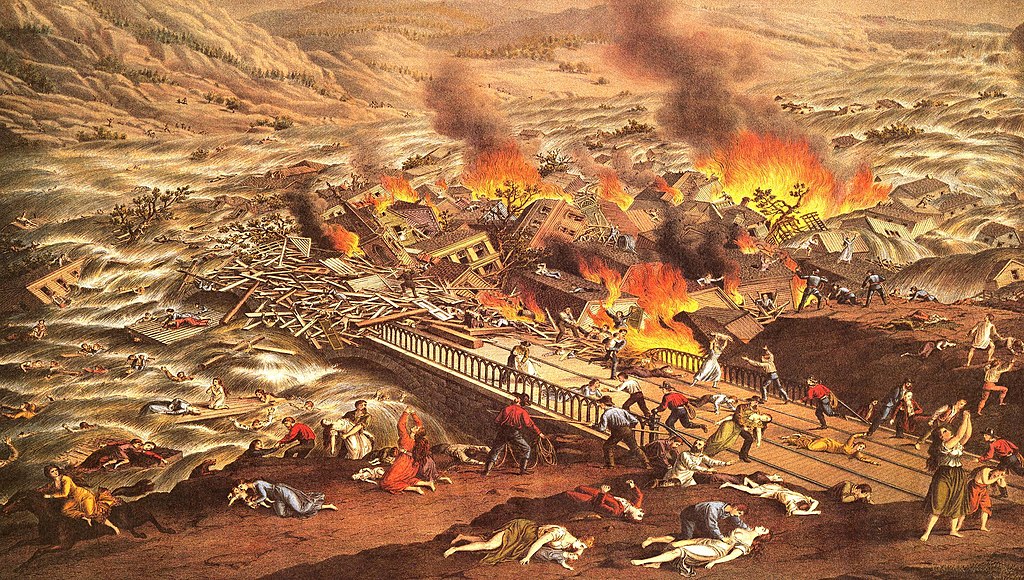In a river valley in central Pennsylvania, heavy rain and a neglected dam lead to a catastrophe in which 2,209 people die and a prosperous city, Johnstown, is nearly wiped off the face of the earth.
It is my sincere desire to provide readers of this site with the best unbiased information available, and a forum where it can be discussed openly, as our Founders intended. But it is not easy nor inexpensive to do so, especially when those who wish to prevent us from making the truth known, attack us without mercy on all fronts on a daily basis. So each time you visit the site, I would ask that you consider the value that you receive and have received from The Burning Platform and the community of which you are a vital part. I can't do it all alone, and I need your help and support to keep it alive. Please consider contributing an amount commensurate to the value that you receive from this site and community, or even by becoming a sustaining supporter through periodic contributions. [Burning Platform LLC - PO Box 1520 Kulpsville, PA 19443] or Paypal
-----------------------------------------------------
To donate via Stripe, click here.
-----------------------------------------------------
Use promo code ILMF2, and save up to 66% on all MyPillow purchases. (The Burning Platform benefits when you use this promo code.)
Johnstown, located at the confluence of the Little Conemaugh River and Stony Creek, was 14 miles downstream from Lake Conemaugh, a reservoir turned recreational lake that was owned and maintained by the prestigious South Fork Fishing and Hunting Club. The sporting club, which catered to a wealthy clientele from nearby Pittsburgh, included Andrew Carnegie and Henry Clay Frick on its membership rolls. Lake Conemaugh was held back by the South Fork Dam, a large earth-fill dam that was completed by the club in 1881. By 1889, the dam was in dire need of repairs.
When several days of heavy rain struck the area in late May 1889, club officials struggled to reinforce the neglected dam, which was under tremendous pressure from the swollen waters of Lake Conemaugh. The dam began to disintegrate, and on May 31 the lake’s water level passed over the top of the dam. Realizing that the dam’s collapse was imminent, club officials sent riders down the valley to evacuate area residents. However, flooding was a familiar occurrence in the valley, and few Johnstown residents heeded the riders’ desperate warnings. Most just took the same simple precautions they did when Little Conemaugh River flooded: They moved their belongings to the second story of their homes and settled down to wait out the storm.
At 3:10 p.m., the South Fork Dam washed away, drowning several laborers who were struggling to maintain it. Club officials on high ground watched awe-struck as 20 million tons of water went roaring down the valley toward Johnstown. The deluge swept through the communities of South Fork, Mineral Point, Woodvale, and East Conemaugh, accumulating debris, including rocks, trees, houses, barns, railroad cars, animals, and people, both dead and alive. By the time it reached Johnstown, at 4:07 p.m., the flood appeared as a rolling hill of debris more than 30 feet high and nearly half a mile wide. In a terrible swoop, the northern half of the city was swept away, sending some 1,500 demolished Johnstown buildings tumbling down with the roaring torrent.
It took 10 minutes for the waters of Lake Conemaugh to pass through Johnstown, and 2,000 people were drowned or crushed in the torrent. A few survivors were washed up along with numerous corpses several miles down the valley. At the old Stone Bridge in Johnstown, debris piled 40 feet high caught fire, and some 80 huddled survivors of the flood perished in the flames. A total of 2,209 died as a result of the disaster.
Among the survivors of the calamity, there was a scarcely an individual who had not lost a friend or relative in the Johnstown Flood. Despite the great scale of the tragedy, reconstruction of the devastated community began almost immediately, and Clara Barton and the American Red Cross constructed shelters for homeless residents while well-wishers around the country sent tons of relief supplies. The South Fork Fishing and Hunting Club was widely criticized for its failure to maintain the South Fork Dam, but no successful lawsuits were ever brought against the organization.




More government protection of their “friends” through the government-controlled “justice” system.
Curious as to what caused the fire… It would be quite ironic to survive a flood like that just to die in a fire surrounded by flood waters.
Wikipedia (yeah, not the best source) seems to indicate a long series of events that eventually led to massive amounts of burning debris piling up at the stone bridge in town. Those events included the washing away of boilers at the iron works and wire factory. As those boilers were probably fueled by oil and other combustable materials like coal, wood, etc., the source of the fire was likely them. Add to that lamp oil in people’s homes and other sources. Interesting painting from the time, showing the fire burning in the debris that piled up.
[img [/img]
[/img]